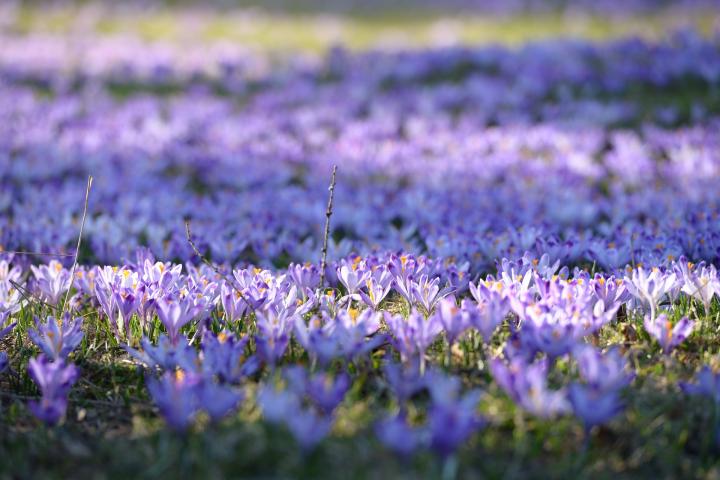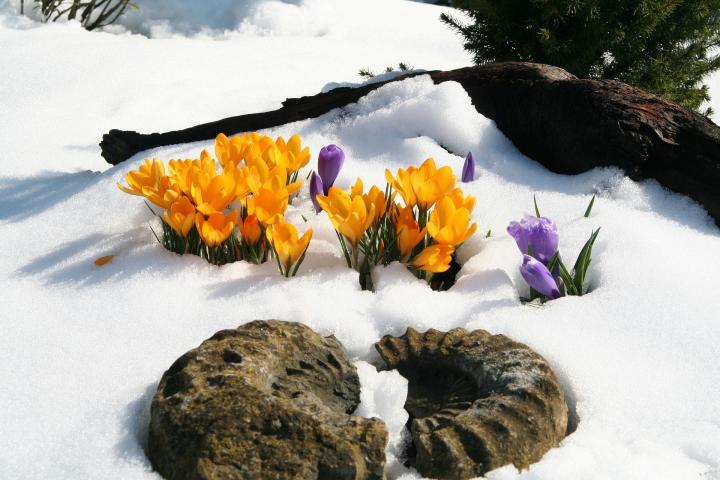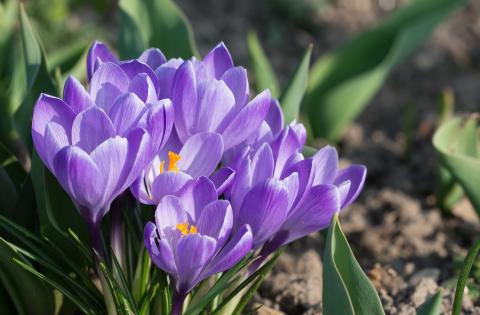When it seems like winter will never lose its icy grip, the dainty crocus pushes through the snow to put on a show of colorful revival. Here’s how to care for the crocuses in your garden!
About Crocuses
From snow crocuses (the first to bloom) to giant Dutch crocuses, all just 2 to 4 inches tall, these blooms offer a variety of colors (pinks, reds, oranges, yellows, purples, blues, and more) that stand out against the bleak late-winter landscape. Many have strong perfumes that lure bees out of their hives in February or March, too, providing the pollinators with an important early-spring food source.
Crocus bulbs (technically called “corms”) not only provide winter garden color, but they naturalize, meaning that they spread and come back year after year—with minimum care—for an ever-larger display. As a bonus, deer, squirrels, and rabbits rarely bother early little crocus corms.
Choose a planting site where there is well-draining soil. The corms will rot in soggy, compacted ground. Crocuses do best in a spot that gets full sun (6+ hours of direct sunlight), but will grow in partial sun as well. Before planting, work in organic matter such as compost to a depth of at least 10 inches.
When to Plant Crocuses
- Crocuses need to experience a period of cold weather in order to bloom, so plant them in the fall for spring blooms.
- Before the ground freezes in the fall, crocus corms can be planted most anywhere, except in the dense shade on the north side of buildings or under thickets.
- Ideally, plant crocus corms 6 to 8 weeks before a hard frost is expected in the fall and when the soil temperature is below 60°F (16°C). This is usually during September or October in the northern U.S. and Canada, and October or November in the southern United States.
How to Plant Crocuses
- Plant crocus corms 3 to 4 inches deep (with the pointy end up). After planting, water well.
- Plant bulbs in groups or clusters rather than spacing them in a single line along a walkway or border. Single flowers get lost in the landscape. Plant a few inches apart, and plant in groups of 10 or more.
- Consider planting crocuses in lawns and meadows where they can form carpets, or mass them in the front of flower beds along the edge.
- Plant taller spring-flowering bulbs and shrubs behind the early bulbs for color contrast.
→ Learn more about planting fall bulbs.
 A carpet of crocuses makes for a wonderful spring sight!
A carpet of crocuses makes for a wonderful spring sight!
- Apply a balanced fertilizer in early autumn if your spring is short and the days heat up fast; or, apply fertilizer after bulbs flower in late winter if your spring is long and temperate. The crocuses will have a chance to use the extra nutrients to produce bigger carbohydrate stores.
- Through the autumn, keep crocus beds watered if weather gets dry, but do not waterlog the soil. Cover the beds with mulch before the winter.
- In late February, remove heavy mulches from snowdrops and crocuses so that the shoots can come through. Leave a light layer of leaves to provide late-season protection from frost.
- In February and March, keep plastic milk jugs or other coverings on hand to protect the flowers of crocuses and other early bloomers against the return of severe weather.
- If you have crocuses growing in your lawn in mid-spring, don’t mow until their leaves have died down.
- Mice, voles, and squirrels may feed on the corms. If they are a problem, consider planting crocuses in buried wire cages.
- Birds sometimes pick off the flowers.
- Corms in storage are prone to rot and molds if kept too moist.
- ‘Bowles White’ produces white flowers with deep golden yellow throats in early spring. It grows 2 to 3 inches tall.
- ‘Flower Record’ has single pale violet flowers in spring to early summer. It grows 4 to 5 inches tall.
- ‘Pickwick’ is a striped crocus with alternating pale and dark lilac and dark purple bases. It’s 4 to 5 inches tall and blooms in spring to early summer.
- ‘Tricolor Crocus’ is a beauty. Each narrow flower has three distinct bands of lilac, white, and golden yellow. It grows 3 inches tall and blooms in late winter and early spring.
- ‘Purpureus Grandiflorus’ has abundance violet flowers with purple bases. It grows 4 to 5 inches tall and blooms spring to early summer.
 Crocuses peaking up through the snow.
Crocuses peaking up through the snow.
- In the language of flowers, crocus means cheerfulness.
And all the woods are alive with the murmur and sound of Spring,
And the rose-bud breaks into pink on the climbing briar,
And the crocus-bed is a quivering moon of fire
Girdled round with the belt of an amethyst ring.
–Oscar Wilde




